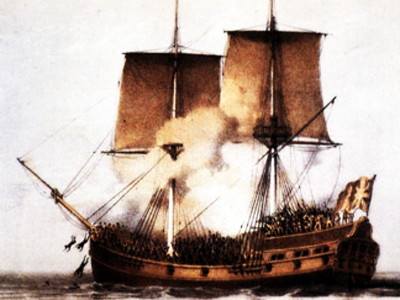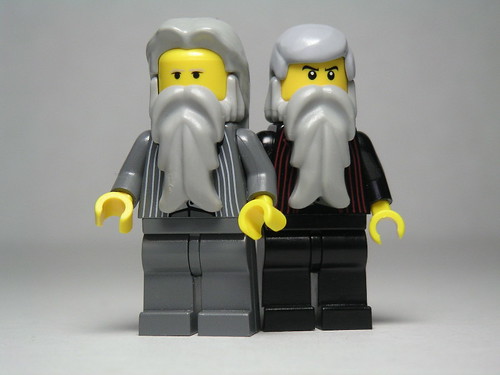 A revolt on a slave ship in 1787
A revolt on a slave ship in 1787In what amounts to a pioneering and path-breaking work, in
The Slave Ship: A Human History Marcus Rediker reminds us of what he calls 'the darker and more violent side' of the history of Atlantic slavery, noting that with their 'abstract, indeed bloodless statistics...even the best histories of the slave trade and slavery have tended to minimise, one might even say sanitise, the violence and terror that lay at the heart of their subjects.' Not that Rediker passes over the bloody facts of the matter, but he contextualises them within the rise of the capitalist system from its breakthrough in Western Europe to global hegemony.
The slave trade lasted almost four hundred years, from the late fifteenth century to the late nineteenth century, and saw over 12 million souls transported across the Atlantic ocean in the greatest forced migration history has ever seen. Almost two million never survived the six to ten week long Middle Passage, whether dying from the ever present danger of deadly disease or from causes man-made, their bodies cast into the sea for the trailing sharks. If one attempts to calculate the initial costs of capturing and enslaving Africans in Africa, and then add the numbers who perished within the first year of work in the New World of the Americas, then some idea of the full horror becomes apparent. 'From stage to stage - expropriation in Africa, the Middle Passage, initial exploitation in America - roughly 5 million men, women and children died. Another way to look at the loss of life would be to say that an estimated 14 million people were enslaved to produce a "yield" of 9 million longer-surviving enslaved Atlantic workers'.
As Rediker notes though, there is a 'violence of abstraction' that has plagued the study of the slave trade and slavery in general. 'Numbers can occulate the pervasive torture and terror, but European, African, and American societies still live with their consequences, the multiple legacies of race, class, and slavery. The slaver is a ghost ship sailing on the edges of modern consciousness'.
Rediker's achievement is to resurrect this ghost ship, to bring back the dead as real living people with names and faces, and to try and let us listen as far as humanly possible to the voices of the voiceless. There is abundant scholarship on the slave trade, but the view from the slave ship itself, Rediker notes, remains 'in many ways unknown'. He describes for example the 'shock and awe' experienced by many Africans on seeing the European slave ships, bristling with cannon, for the first time. How did they sail? Did magical spirits make them start and stop? As the young eleven year old Olaudah Equiano was taken on board a ship with his enslaved fellow Africans, he felt astonished and terrified at the savagery on display by the 'white men', the motley crew of mainly European sailors. What did they want from him? Only a child, he feared cannabalism and being eaten alive, but some older slaves on board offered him comfort and 'gave me to understand we were to be carried to these white people's country to work for them'. Equiano of course was to have an extraordinary life, and grew up to become an abolitionist and author of the 'most influential literary work of the abolitionist movement from an African perspective'.
Rediker is at his strongest in describing how the slave ship and its crew changed through each leg of its journey, looking from the point of view of the increasingly tyrannical ship's captain, the motley crew of mariners, and the rebellious multitude of the enslaved. At first it looked a thing of beauty when constructed, then the slaver became a 'vast machine' from the point of view of its working crew, then a 'floating dungeon' housing a 'macabre chamber of horrors' from the point of view of both the sailors and the enslaved during the Middle Passage. In the process, racial thinking and ideas emerges, and 'race' is made and remade as the ship sails its course. The systematic terror and violence that it was necessary to deploy on board by the captain and crew against the enslaved in order to prevent the ever present danger of insurrection is also an overriding theme. The captives outnumbered the crew ten to one, and an estimated one in ten voyages saw an uprising. Rediker carefully describes the complicated 'deep dialectic of discipline and resistance' on board the slaves ships, from individual attempts to resist to mass collective acts of explosive opposition.
Explosive is the right word - sometimes the slaves succeeded in blowing up the whole ship with gunpowder - and an estimated total of 100,000 people died in insurrections in the history of the slave trade - with an average of 25 people killed in each attempted rising. Most uprisings failed - the whole slave ship was built as a prison in order to precisely stop them even getting off the ground, and there was a stash of weapons and torture equipment on board to punish and humiliate. To rise up, the unarmed enslaved had to first free themselves from their iron manacles and shackles, then escape from their dungeon below deck, and then try to take control of the ship by force against a crew armed with cutlasses and blunderbusses, often protected by a barricado especially constructed on the upper deck for just such an eventuality. If they did all that, they would then need to work out how to sail the ship itself. The vast majority of insurrections inevitably failed, and then the punishment meted out against the organisers of the rebellion was brutal and sadistic - as all counter-revolutionary violence tends to be. John Newton, a slave captain who later in life was to commit himself to the cause of abolition, once wrote in a private letter describing what he witnessed on board the
Brownlow during its voyage of 1748-9. After a failed insurrection, the good Christian captain, Richard Jackson, sentenced the rebellious slaves to death. The first group:
'He jointed; that is, he cut off, with an axe, first their feet, then their legs below the knee, then their thighs; in like manner their hands, then their arms below the elbow, and then their shoulders, till their bodies remained only like the trunk of a tree when all their branches are lopped away; and lastly, their heads. And, as he proceeded in his operation he threw the reeking members and heads in the midst of the bulk of the trembling slaves, who were chained upon the main-deck.'The second group of rebellious slaves:
'He tied round the upper parts of the heads...a soft, platted rope, which the sailors call a point, so loosely as to admit a short lever: by continuing to turn the lever, he drew the point more and more tight, till at length he forced their eyes to stand out of their heads; and when he had satiated himself with their torments, he cut their heads off.'As Newton noted, 'a savageness of spirit, not easily conceived, infuses itself...into those who exercise power on board an African slave ship, from the captain downwards...it is the spirit of the trade'. Why such murderous barbarity? In part it was necessary to counter this enslaved African resistance, what Thomas Clarkson called those moments of 'the brightest Heroism [that] happen in the Holds or on the Decks of the slave vessels'. The economic costs of slave resistance were high - and resistance 'significantly reduced the shipments of slaves' to America by an estimated one million over the full history of the slave trade.
By the end of the 1780s, as Rediker notes, abolitionists were able to use the powerful image of the slave ship, built up by the likes of Thomas Clarkson, to demonstrate 'that the vessel that had carried millions of Africans into slavery also carried something else: the seeds of its own destruction'.
What made such a cruel barbaric system last so long? Well, the plantations of the Americas were able to devour the labour of Africans because there were huge profits to be made by merchant capitalists. In 1807 alone, one year, Britain imported for domestic consumption 297.9 million pounds of sugar, 3.77 million galleons of rum, 16.4 million pounds of tobacco and 72.74 million pounds of cotton, almost all of it produced by enslaved labour. The slave ship 'was a concentration of capital, and it was the bearer of capitalist assumptions and practices about the world and the way it ought to be.' As Rediker noted in a recent
interview:
We sometimes think of slavery as being pre-capitalist or non-capitalist, and that capitalism only really begins with free waged labour, but I think that blinds us to a lot of very important processes.
People were expropriated in one setting and then moved to a more market-orientated setting where their labour was exploited through usually quite violent means. In that way the slave trade is emblematic of a larger process that is happening to workers everywhere.
All these enslaved Africans were moved to the western Atlantic plantation system and their lives would be consumed by producing sugar, tobacco and rice for the world market. I like to paraphrase the great Guyanese scholar and activist Walter Rodney who said that in the slave trade capitalism paraded without even a loincloth to cover its nakedness.Today, when the great imperial powers are again using all kind of sophistry in order to try and
re-colonise Africa, a historical understanding of the utterly barbaric methods by which European merchant capital under-developed Africa through the slave trade could not be more necessary. There could be few better introductions than Rediker's vivid and panoramic history, which surely deserves to become the classic account of life and death on the slave ships.
Labels: Africa, books, empire, history, race, slavery








